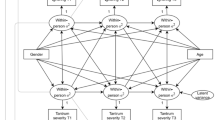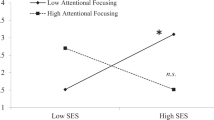Abstract
Behavioral inhibition is a temperamental trait that refers to slow approach to novel items, shyness towards new people, and fearfulness in new situations, and individuals may develop inhibited response styles by as early as 2 years of age. There are important methodological considerations in the assessment of early temperament, with parental report and observational measures providing both corroborative and unique data. The present study examined behavioral inhibition measured by parental report and observational measures in a genetically informative sample to delineate the agreement between the methods and the uniqueness of each method, and to estimate the magnitude of genetic and environmental influences on the common and unique variance. The biometric, psychometric, and rater bias models were conducted to study the covariance between measurement modalities. Overall, the results suggested a common phenotype was assessed by both parents and observers. The latent phenotype underlying parental and observational measures of behavioral inhibition was moderately to substantially heritable.


Similar content being viewed by others
Notes
Confirmatory and exploratory factor analyses (EFA) were conducted in Mplus to determine the factor structure of the home shyness variables. The variables loading on the “Approach” factor were average shyness, proximity to the researcher, and playing with the novel toy. The variables loading on the “Cling” factor were proximity to mother, touching mother, and clinging to mother.
References
Askan N, Kochanska G (2004) Links between systems of inhibition from infancy to preschool years. Child Dev 75(5):1477–1490
Bayley N (1969) Manual for the Bayley scales of infant development. Psychological Corporation, New York
Bentler PM (1990) Comparative fit indexes in structural models. Psychol Bull 107:238–246
Browne MW, Cudeck R (1993) Alternative ways of assessing model fit. In: Bollen KA, Long JS (eds) Testing structural equation models. Sage, Newbury Park, pp 136–162
Carey WB, McDevitt SC (1978) Stability and change in individual temperament diagnoses from infancy to early childhood. Am Acad Child Psychiatry 17:331–337
Caspi A, Moffitt TE, Newman DL, Silva PA (1996) Behavioral observations at age 3 years predict adult psychiatric disorders: longitudinal evidence from a birth cohort. Arch Gen Psychiatry 53:1033–1039
Cronbach LJ, Rajaratnam K, Gleser GC (1963) Theory of generalizability: a liberalization of reliability theory. Br J Math Stat Psychol 16:137–163
Derks EM, Dolan CV, Boomsma DI (2006) A test of the equal environment assumption (EEA) in multivariate twin studies. Twin Res Hum Genet 9(3):403–411
Eaves L, Foley D, Silberg J (2003) Has the ‘equal environments’ assumption been tested in twin studies? Twin Res 6:486–489
Eley TC, Bolton D, O’Connor TG, Perrin S, Smith P, Plomin R (2003) A twin study of anxiety-related behaviors in pre-school children. J Child Psychol Psychiatry 44(7):945–960
Else-Quest NM, Shibley Hyde J, Goldsmith HH, Van Hulle CA (2006) Gender differences in temperament: a meta-analysis. Psychol Bull 132(1):33–72
Emde RN, Plomin R, Robinson J, Corley R, DeFries J, Fulker DW, Reznick JS, Campos J, Kagan J, Zahn-Waxler C (1992) Temperament, emotion, and cognition at fourteen months: the MacArthur longitudinal twin study. Child Dev 63:1437–1455
Gest SD (1997) Behavioral inhibition: stability and associations with adaptation from childhood to early adulthood. J Pers Soc Psychol 72(2):467–475
Goldsmith HH, Lemery KS (2000) Linking temperamental fearfulness and anxiety symptoms: a behavior-genetic perspective. Biol Psychiatry 48:1199–1209
Hewitt JK, Silberg JL, Neale MC, Eaves LJ, Erickson M (1992) The analysis of parental ratings of children’s behavior using LISREL. Behav Genet 22(3):293–317
Hu L, Bentler PM (1998) Fit indices in covariance structure modeling: sensitivity to underparameterized model misspecification. Psychol Methods 3:424–453
Izard CE, Huebner R, Risser D, McGinnes GC, Dougherty L (1980) The young infant’s ability to produce discrete emotional expressions. Dev Psychol 16:132–140
Kagan J (2001) The structure of temperament. In: Emde RN, Hewitt JK (eds) Infancy to early childhood: genetic and environmental influences on developmental change. Oxford University Press, Oxford, pp 45–51
Kagan J, Saudino KJ (2001) Behavioral inhibition and related temperaments. In: Emde RN, Hewitt JK (eds) Infancy to early childhood: genetic and environmental influences on developmental change. Oxford University Press, Oxford, pp 111–119
Kagan J, Reznick JS, Clarke C, Snidman N, Garcia-Coll C (1984) Behavioral inhibition to the unfamiliar. Child Dev 55:2212–2225
Karevold E, Coplan R, Stoolmiller M, Mathiesen KS (2011) A longitudinal study of the links between temperamental shyness, activity, and trajectories of internalising problems from infancy to middle childhood. Aust J Psychol 63:36–43
Keenan K, Shaw D (1997) Developmental and social influences on young girls’ early problem behavior. Psychol Bull 121(1):95–113
Kendler KS, Baker JH (2007) Genetic influences on measures of the environment: a systematic review. Psychol Med 37:615–626
Kendler KS, Neale MC, Kessler RC, Heath AC, Eaves LJ (1993) A test of the equal-environment assumption in twin studies of psychiatric illness. Behav Genet 23(1):21–27
Kochanska G, DeVet K, Goldman M, Murray K, Putnam SP (1994) Maternal reports of conscience development and temperament in young children. Child Dev 65(3):852–868
Lahey BB, Waldman ID (2003) A developmental propensity model of the origins of conduct problems during childhood and adolescence. In: Lahey BB, Moffitt TE, Caspi A (eds) Causes of conduct disorder and juvenile delinquency. Guilford, New York, pp 76–117
Letcher P, Smart D, Sanson A, Toumbourou JW (2009) Psychosocial precursors and correlates of differing internalizing trajectories from 3 to 15 years. Soc Dev 18(3):618–646
Matheny AP (1980) Bayley’s infant behavior record: behavioral components and twin analyses. Child Dev 51(4):1157–1167
Muthén LK, Muthén BO (1998–2010) Mplus user’s guide, 6th edn. Muthén & Muthén, Los Angeles
Neale MC, Cardon LR (1992) Methodology for genetic studies of twins and families. Kluwer, Dordrecht
Neale MC, Maes HHM (2004) Methodology for genetic studies of twins and families. Kluwer, Dordrecht
Neale MC, Boker SM, Xie G, Maes HH (2003) Mx: statistical modeling, 6th edn. Department of Psychiatry, VCU, Richmond
Rhea S, Gross AA, Haberstick BC, Corley RP (2006) Colorado twin registry. Twin Res Hum Genet 9(6):941–949
Rhee SH, Waldman ID (2002) Genetic and environmental influences on antisocial behavior: a meta-analysis of twin and adoption studies. Psychol Bull 128(3):490–529
Rhee SH, Cosgrove VE, Schmitz S, Haberstick BC, Corley RC, Hewitt JK (2007) Early childhood temperament and the covariation between internalizing and externalizing behavior in school-aged children. Twin Res Hum Genet 10(1):33–44
Robinson JL, Kagan J, Reznick JS, Corley R (1992) The heritability of inhibited and uninhibited behavior: a twin study. Dev Psychol 28(6):1030–1037
Rothbart MK, Goldsmith HH (1985) Three approaches to the study of infant temperament. Dev Rev 5:237–260
Rowe DC, Plomin R (1977) Temperament in early childhood. J Pers Assess 41:150–156
Rubin KH, Coplan RJ (2004) Paying attention to and not neglecting social withdrawal and social isolation. Merrill-Palmer Q 50(4):506–534
Sanson A, Pedlow R, Cann W, Prior M, Oberklaid F (1996) Shyness ratings: stability and correlates in early childhood. Int J Behav Dev 19(4):705–724
Saudino KJ, McGuire S, Reiss D, Hetherington EM, Plomin R (1995) Parent ratings of EAS temperaments in twins, full siblings, half siblings, and step siblings. J Pers Soc Psychol 68(4):723–733
Saudino KJ, Cherny SS, Plomin R (2000) Parent ratings of temperament in twins: explaining the ‘too low’ DZ correlations. Twin Res 3:224–233
Terman LH, Merrill MA (1973) Stanford–Binet intelligence scale: 1972 norms edition. Houghton-Mifflin, Boston
van der Valk JC, van den Oord EJCG, Verhulst FC, Boomsma DI (2001) Using parental ratings to study the etiology of 3-year-old twins’ problem behaviors: different views or rater bias? J Child Psychol Psychiatry 42(7):921–931
Wachs TD (1992) Issues in the measurement of biological and behavioral indices of temperament. In: Paper presented at the ninth occasional temperament conference, Bloomington, Oct 29–31 1992 (cited in Sanson et al. 1996)
Acknowledgments
This research was supported by grants from the MacArthur Foundation, and grants NIH HD010333, HD050346, HD007289, and MH063207. The authors thank the participants and research assistants for their participation and assistance with this project.
Author information
Authors and Affiliations
Corresponding author
Additional information
Edited by Yoon-Mi Hur.
Rights and permissions
About this article
Cite this article
Smith, A.K., Rhee, S.H., Corley, R.P. et al. The Magnitude of Genetic and Environmental Influences on Parental and Observational Measures of Behavioral Inhibition and Shyness in Toddlerhood. Behav Genet 42, 764–777 (2012). https://doi.org/10.1007/s10519-012-9551-0
Received:
Accepted:
Published:
Issue Date:
DOI: https://doi.org/10.1007/s10519-012-9551-0




